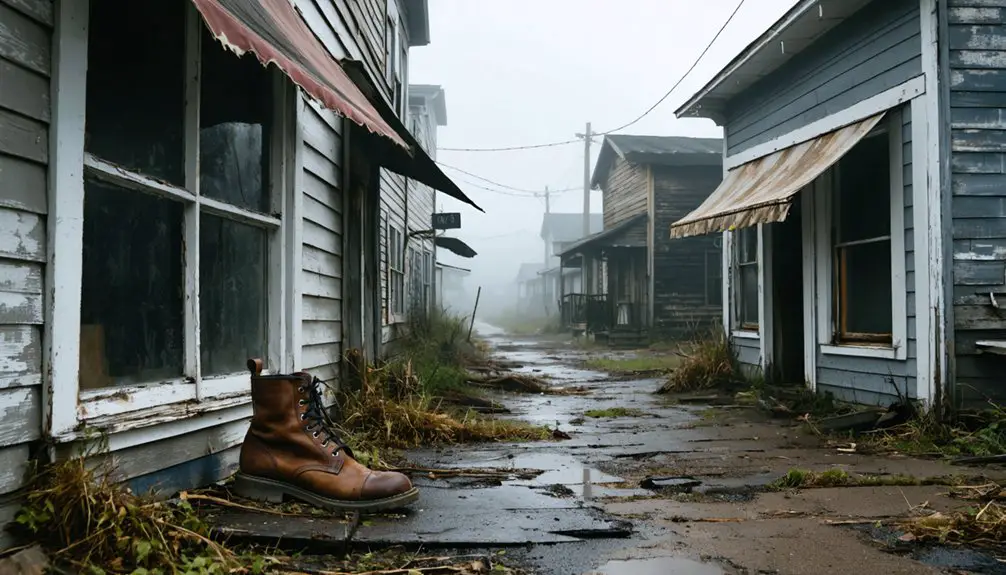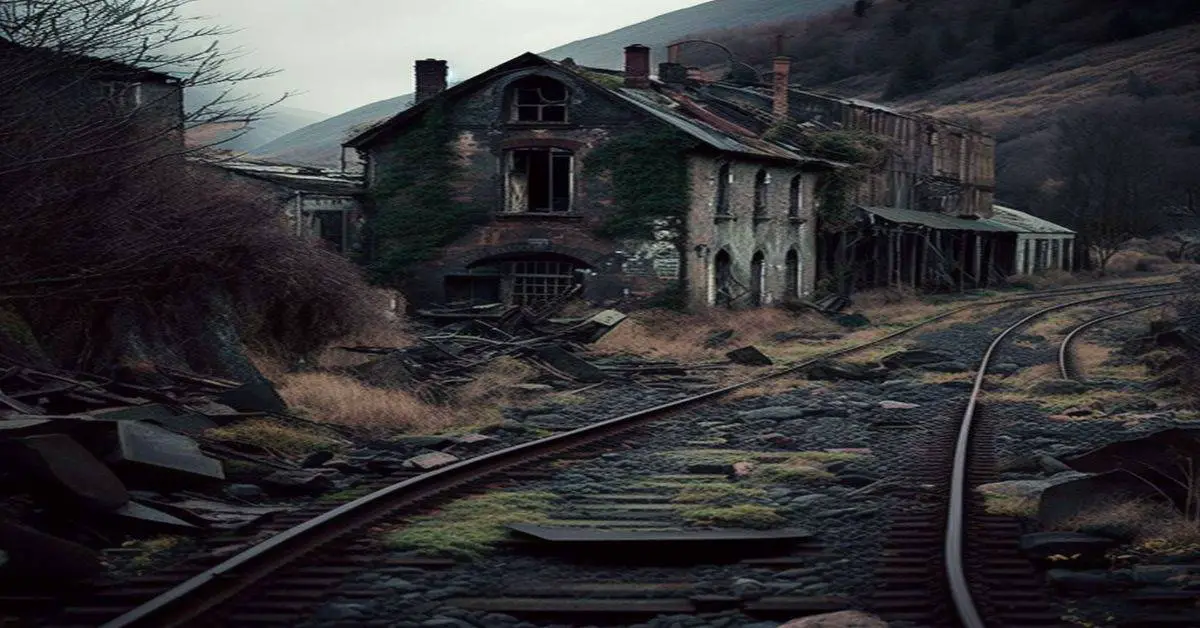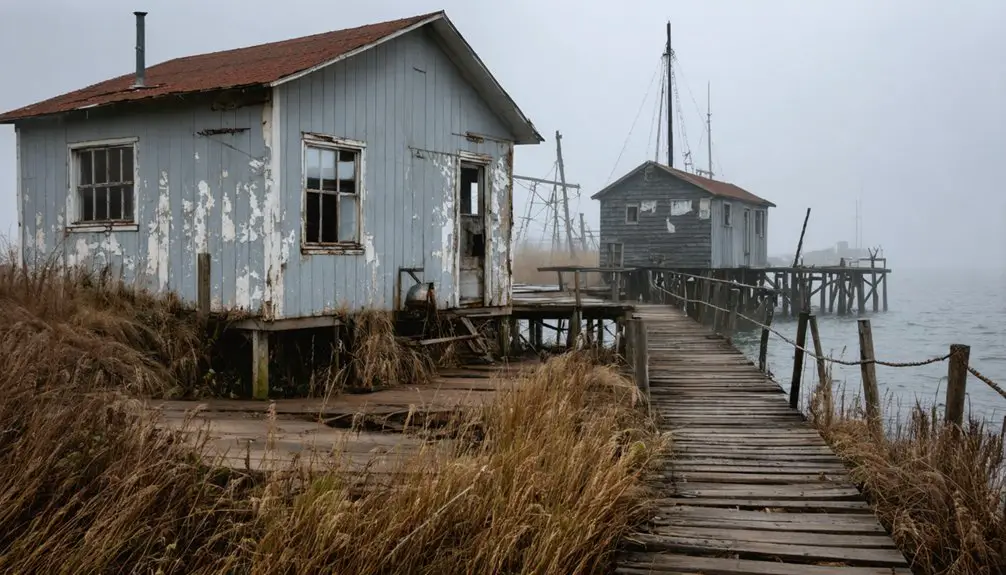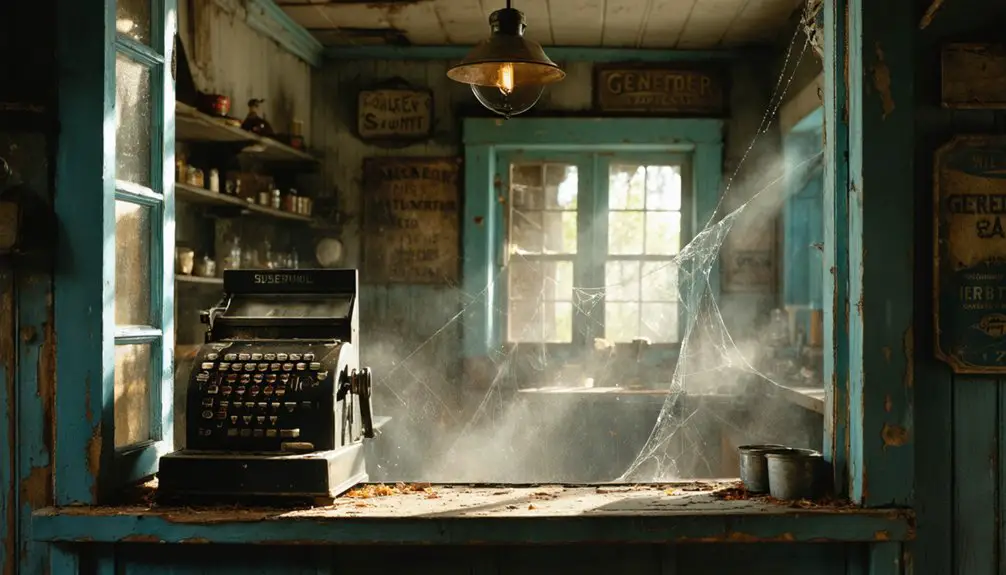You’ll find Manson’s remains 3 miles northeast of Heafford Junction in northern Wisconsin, where it once flourished as a logging settlement along US Highway 8 and the Canadian National Railway. The town emerged in the early 20th century, centered around timber operations and Scottish immigrant workers, before declining as logging opportunities dwindled. By 1939, this once-bustling outpost at 1,519 feet elevation near Manson Lake had transformed into a ghost town, its story preserved in the region’s forested landscape.
Key Takeaways
- Manson was a small Wisconsin logging community located 3 miles northeast of Heafford Junction along US Highway 8.
- The town’s economy centered around timber operations, with the Rudolf Otto Mill introducing single-rotary technology in 1887.
- Manson appeared on USGS maps until 1939, strategically positioned along the Canadian National Railway for timber transport.
- The community declined when timber reserves were depleted, leading to population exodus and infrastructure deterioration.
- The ghost town sits near Manson Lake at 1,519 feet elevation, surrounded by mixed forests and glacially-shaped terrain.
The Rise and Fall of a Northern Settlement
While many northern Wisconsin settlements rose and fell with the timber industry, Manson’s story began as a small outpost along what’s now US Highway 8, roughly 3 miles northeast of Heafford Junction.
Northern Wisconsin’s timber towns came and went, with Manson emerging as a modest waypoint near Heafford Junction.
You’ll find its logging heritage deeply rooted in the early 20th century, when the settlement emerged near the pristine waters of Manson Lake.
The community dynamics revolved around timber operations, with residents building a life around small-scale commerce and essential services.
You can trace Manson’s peak through its appearance on USGS maps until 1939, but like many logging towns, its fate was sealed by depleted timber resources.
As the economic foundation crumbled, families gradually departed, leaving behind their rural haven.
Like the Scottish origin of its namesake, the town reflected the heritage of many immigrant workers who settled there.
Though there were no murders here like at Cielo Drive, the area has its own share of haunting stories from its abandoned past.
Life Along the Canadian National Railway
If you’d lived in Manson during the railroad’s heyday, you’d have witnessed CN railway workers managing multiple daily freight runs through northern Wisconsin’s challenging terrain.
You’d have seen crews working around the clock, switching cars at local industries and coordinating with dispatchers to maintain precise schedules between major hubs like Superior and Chicago. Operating a vast network of standard gauge track stretching 2,850 miles across multiple states, the railroad served as a vital transportation link. The railroad’s operations expanded significantly when Wisconsin Central Limited was acquired by Canadian National in 2001.
The rhythmic sounds of freight operations, from the rumble of diesel locomotives to the metallic clang of coupling cars, would have marked your days as rail workers kept the lifeblood of commerce flowing through this small Wisconsin settlement.
Railway Workers’ Daily Routines
Life along the Canadian National Railway demanded rigorous dedication from its workers, who operated under a relentless 24/7/365 schedule. You’d find yourself adapting to unpredictable shift patterns, starting as early as 7 a.m. and potentially working well into the night.
As a railway worker, you’d need to stay ready for calls at any hour, often sacrificing holidays and family events for the job. The position required workers to be prepared for overnight stays away from home. Conductors played an essential role in building outbound trains as they organized blocks of cars.
Your daily routine would begin with safety briefings, followed by physical tasks like servicing locomotives, managing switches, and arranging train cars. You’d need to master strict safety protocols through thorough training at facilities like the Winnipeg campus.
The work environment was challenging – you’d face harsh weather, heavy machinery, and the constant need to stay alert while balancing physical demands with mental sharpness.
Freight Operations and Impact
Beyond the daily routines of railway workers, Canadian National Railway’s freight operations have shaped Wisconsin’s economic landscape through substantial infrastructure investments.
You’ll find CN’s commitment reflected in their $110 million investment planned for 2025, matching their 2024 spending on essential infrastructure upgrades across their 988-mile network in the state.
As you travel near Manson, you’ll notice how CN’s presence affects daily life along the railway corridor.
Their focus on freight efficiency means continuous track maintenance and technology upgrades, while their dedication to community safety involves crossing improvements and noise management.
CEO Tracy Robinson emphasizes the company’s dedication to building for tomorrow through strategic network investments.
These investments guarantee reliable transportation lifelines for Wisconsin’s industries, connecting you to major markets like Chicago while supporting the 1,200 CN employees who keep goods moving through your communities. The company’s extensive reach spans eight Canadian provinces and serves nearly a dozen U.S. states through its integrated network.
Geographic Features and Natural Surroundings
You’ll find Manson nestled along Manson Lake at 1,519 feet above sea level, where the glacially-shaped terrain features gentle hills covered in mixed coniferous and deciduous forests.
The ghost town’s location within Oneida County places it in a region where lakes and wetlands comprise 6.39% of Woodboro’s total area, creating a rich tapestry of water features typical of northern Wisconsin’s geography. Like many abandoned timber towns, the area’s landscape was dramatically transformed by intensive logging operations during the early 20th century.
The surrounding natural environment, positioned at roughly 45°34′00″N latitude and 89°39′41″W longitude, supports diverse wildlife within its boreal and mixed forest ecosystem, shaped by both historic logging activities and natural processes. The town sits at a notable elevation of 1,617 feet, making it one of the higher points in the surrounding landscape.
Lake and Land Features
The rugged landscape of Manson, Wisconsin nestles along Manson Lake in Oneida County, where U.S. Highway 8 and the Canadian National Railway corridor intersect.
You’ll find this ghost town’s terrain shaped by glacial forces, creating a mix of rolling hills and flat lake basins at 1,519 feet above sea level.
The area’s lake ecology thrives across 2.4 square miles of water features, while 34.6 square miles of land usage showcases the region’s characteristic sandy and loamy soils.
Manson Lake serves as the centerpiece, surrounded by mixed conifer-deciduous forests and interconnected wetlands.
The natural drainage system supports numerous small lakes and streams, forming crucial land-water boundaries that were essential to the town’s historical development and transportation networks.
Native Flora Composition
Manson’s rich native flora showcases distinctive plant communities adapted to its sandy barrens environment, where jack pine and red pine dominate the canopy alongside drought-tolerant understory species.
You’ll find native plant adaptations throughout the landscape, including sweet fern, lowbush blueberry, and bearberry carpeting the forest floor.
The area’s ecological significance is evident in its diverse prairie elements, where big bluestem and little bluestem grasses thrive alongside showy forbs like rough blazing star and anise hyssop.
Some species, like prairie snakecotton and Cleland’s evening primrose, reach their northern range limits here.
With roughly 140 native species documented in these small barrens sites, you’re witnessing a remarkably concentrated biodiversity that’s maintained through periodic fires and careful conservation efforts.
Local Terrain Characteristics
Nestled within Oneida County‘s northern Wisconsin landscape, Manson occupied a strategic location at the intersection of US Highway 8 and the Canadian National Railway, approximately 3 miles northeast of Heafford Junction.
The terrain analysis reveals relatively flat to gently rolling landforms, shaped by Pleistocene glaciation that left its mark across the region.
You’ll find the soil composition consists primarily of glacial deposits, sands, and organic matter, particularly near Manson Lake’s shores.
The terrain shifts from wetlands along the lakeshore to mixed forests inland, creating diverse ecological zones. This natural layout proved advantageous for early settlement, logging operations, and railway construction.
While much of the original landscape has rewilded since the town’s abandonment, you can still spot the lasting imprints of human activity through remnant railway beds.
Transportation Routes and Their Impact

Strategically positioned along what would become U.S. Route 8, Manson’s transportation evolution reflected the dynamic shifts in northern Wisconsin’s development.
You’ll find the town’s history deeply intertwined with the region’s logistical challenges and changing transit patterns.
The Canadian National Railway‘s presence near Manson created crucial connections that shaped the community’s destiny:
- Rail lines enabled efficient timber transport from local logging operations to southern markets
- The rail-road combination provided fundamental passenger service for the town’s residents
- Early plank roads and indigenous trails formed the foundation for modern Highway 8
- River transport initially supplemented land routes until rail dominated freight movement
When rail service declined and auto transport reshaped travel patterns, Manson’s strategic advantages diminished, contributing to its eventual abandonment.
Early Development and Community Growth
The settlement of Manson took root along Manson Lake in Woodboro, Oneida County, during northern Wisconsin’s logging era. Like many logging communities in the region, you’d have found workers busily clearing timber and struggling with the challenges of transforming cutover lands into farmable soil.
The town’s early growth reflected the typical pattern of northern Wisconsin’s boom-and-bust cycle. You would’ve seen transient populations moving through as they followed logging opportunities, while others attempted to establish more permanent roots.
The community faced significant hurdles, including poor soil conditions and the arduous task of removing tree stumps, which could take over a decade. Despite these challenges, the settlement maintained enough prominence to appear on USGS maps through 1939, supported by its strategic location along the railway and what would become US Highway 8.
Economic Activities and Local Industries
During Manson’s peak years, logging dominated the local economy, with sawmills and timber processing facilities scattered throughout Oneida County.
You’d find state-of-the-art operations like the Rudolf Otto Mill near Mill Lake, which introduced single-rotary technology in 1887. The Mason-Donaldson Lumber Co.’s investments in logging infrastructure transformed the area into a bustling industrial hub.
- Timber processing facilities included sawmills, planing mills, and logging camps
- Company stores and boarding houses supported the workforce
- The Canadian National Railway enabled efficient timber export
- Agriculture emerged as a secondary industry when logging declined
While farming attempts followed the logging era, poor soil quality and short growing seasons limited agricultural success.
Many settlers who bought cutover lands at bargain prices soon abandoned their dreams of farming prosperity.
The Path to Abandonment
Much like other Wisconsin logging towns, Manson’s decline began when timber reserves dwindled in the early 20th century. The town’s limited economic opportunities and lack of community resilience led to a gradual exodus, particularly among younger residents seeking better prospects elsewhere.
You can trace Manson’s path to abandonment through its deteriorating infrastructure along US 8 and the former Canadian National Railway routes. As essential services closed and buildings fell into disrepair near Manson Lake, the town’s viability weakened.
By 1939, USGS maps still marked the settlement, but its fate was sealed. The shifting regional economy and transportation patterns drew people to neighboring communities, while the remaining structures succumbed to nature.
Today, the wilderness has reclaimed much of what was once a bustling lakeside community.
Historical Documentation and Maps
Numerous historical maps and documents trace Manson’s existence through vital stages of its decline. You’ll find the town’s presence preserved in USGS maps until 1939, with Victor Bates’ detailed 1969 ghost town documentation providing essential geographical context.
The Wisconsin Historical Society’s map preservation efforts have maintained these essential records, showing Manson’s strategic location near US 8 and the Canadian National Railway.
Key aspects of Manson’s historical documentation include:
- Precise positioning within Woodboro, Oneida County, approximately 3 miles from Heafford Junction
- Detailed representation on maps scaled at 1 inch to 10 miles
- Inclusion in the modern *Vanishing Wisconsin* digital atlas project
- Archival storage of original prints at the Wisconsin Historical Society in Madison
Legacy in Wisconsin’s Settlement History
As a pivotal settlement in Oneida County’s lumber era, Manson exemplified northern Wisconsin’s rapid industrialization in the late 19th century. You’ll find its strategic location along US 8 and the Canadian National Railway made it a crucial hub for timber transport and trade, while Manson Lake enhanced its logging industry connections.
Like many frontier settlements, Manson’s community dynamics reflected the boom-and-bust nature of resource-dependent towns. You’d have seen hundreds of residents, including immigrant workers, creating a vibrant local economy with shops and gathering places.
When devastating fires and the decline of logging struck, these communities dispersed, with families seeking opportunities elsewhere. Today, Manson’s ghost town status serves as a symbol of Wisconsin’s northern frontier heritage and the transient nature of single-industry settlements.
Frequently Asked Questions
What Indigenous Tribes Originally Inhabited the Area Around Manson?
You’ll find the Ho-Chunk were primary inhabitants, with Ojibwe culture and Menominee territory overlapping in the region. Other tribes like Sauk, Fox, and Dakota also traversed these ancestral Wisconsin lands.
Were There Any Notable Disasters or Accidents That Contributed to Manson’s Decline?
You won’t find any documented natural disasters or industrial accidents that led to the town’s decline. Instead, it’s likely the town faded due to economic changes and transportation shifts.
Who Was the Town of Manson Named After?
Truth is stranger than fiction, but you can’t definitively know who Manson was named after. Despite research into Manson’s history and origins, historical records don’t reveal the specific namesake of this place.
Did Any Famous People or Events Originate From Manson?
You won’t find any famous residents or significant historical events originating from this location. Historical records and local archives don’t document any nationally or regionally notable people or happenings from there.
Are There Any Remaining Structures or Cemeteries in Manson Today?
You won’t find any confirmed remaining buildings or historical markers at this location today. The town’s structures have vanished, and there’s no documented evidence of surviving cemeteries in the area.
References
- https://en.wikipedia.org/wiki/Manson
- https://usghostadventures.com/haunted-stories/the-legend-of-doveland-wisconsin-the-vanishing-town/
- https://www.youtube.com/watch?v=WEtw9TN-AeQ
- https://www.wikiwand.com/en/articles/Manson
- https://pbswisconsin.org/news-item/southern-wisconsins-ghost-towns-leave-behind-vital-stories/
- https://www.americanghostwalks.com/investigating-the-oman-house
- https://www.youtube.com/watch?v=Lr3PYbaeL0k
- http://shunpikingtoheaven.blogspot.com/2016/05/a-wisconsin-ghost-town.html
- https://www.americanghostwalks.com/articles/1-madison-wisconsin-camp-randall-ghosts
- https://www.trains.com/trn/railroads/history/canadian-national-merger-family-tree/



